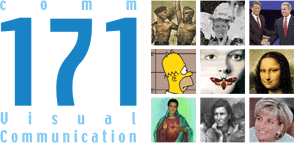
Office: HGH 210; phone: (408) 924-5378
Email: wooda@email.sjsu.edu
Web: http://www.sjsu.edu/faculty/wooda
 |
Dr. Andrew Wood Office: HGH 210; phone: (408) 924-5378 Email: wooda@email.sjsu.edu Web: http://www.sjsu.edu/faculty/wooda |
Reading:
Sturken, M, & Cartwright, L. (2001). Practices of looking: An introduction to visual culture. New York: Oxford University Press.
| Note: These comments are not designed to "summarize" the reading. Rather, they are available to highlight key ideas that will emerge in our classroom discussion. As always, it's best to read the original text to gain full value from the course. |

In Chapter Nine (pp. 315-348), the authors explore the impact of globalization upon the construction of images. As various "texts" are transmitted across cultures, how are they produced differently than if they might only be viewed by a specific public? Moreover, in what ways do globally transmitted images serve to perpetuate concentrations of power in the hands of a few people? Addressing these questions, the authors concentrate initially on the role of television in the communication of visual images.
In what ways does television communicate national values beyond national borders? The authors describe ways in which U.S. television shows have been argued to represent American values, even to reflect a form of cultural imperialism. Similarly, multinational brands such as the ubiquitous Coca-Cola logo represent the power of huge companies over local producers, demonstrating that postcolonial power does not emanate from the barrel of a gun. At the same time, many local communities in the so-called "third world" have begun to use these same media for their own purposes, either by appropriating images in subtle forms of resistance or employing the technology to craft culturally-specific messages for both localized and diasporadic communities.
The authors conclude by noting the use of the Internet to encourage more rapid convergence of formally distinct media companies and technologies and its potential as a site of counter-hegemonic discourse. An open question remains: shall online interaction enable the flow of images and idea that can destabilize dominant modes of power, or shall a small group of individuals and nations employ this medium as they have others to further shape the very ways we conceive of power and freedom?